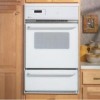Maytag CWG3100AAE Use & Care Guide - Page 5
Aluminum Foil, Positioning Racks and Bakeware, Oven Vent, Baking and Roasting, Broiling - parts
 |
UPC - 719881043210
View all Maytag CWG3100AAE manuals
Add to My Manuals
Save this manual to your list of manuals |
Page 5 highlights
Aluminum Foil IMPORTANT: To avoid permanent damage to the oven bottom finish, do not line the oven bottom with any type of foil or liner. For best cooking results, do not cover entire oven rack with foil because air must be able to move freely. Positioning Racks and Bakeware IMPORTANT: To avoid permanent damage to the porcelain finish, do not place food or bakeware directly on the oven door or bottom. Rack Positions Rack 4: Use for broiling and 2-rack baking. Bakeware To cook food evenly, hot air must be able to circulate. Allow 2" (5 cm) of space around bakeware and oven walls. Make sure that no bakeware piece is directly over another. Racks Rack 3: Most baked goods on a cookie sheet or jelly roll pan, layer cakes, frozen convenience foods. Broiling chicken pieces. Rack 2: Roasting small cuts of meat, pies, loaves of bread, bundt cakes, and 2-rack baking. NOTE: For best performance, place bakeware from front to back. ■ Position racks before turning on the oven. Rack 1: Roasting large cuts of meat and poultry. ■ Do not move racks with bakeware on them. Multiple Rack Cooking ■ Make sure racks are level. To move a rack, pull it out to the stop position, raise the front edge, and then lift out. Use the following illustration and charts as a guide. 2-rack: Use rack positions 2 and 4 or 1 and 4. Baking Layer Cakes on 2 Racks For best results when baking cakes on 2 racks use racks 2 and 4 or 1 and 4 for baking. Place the cakes on the racks as shown. 4 3 2 1 A. Control panel B. Oven vent C. Oven door Oven Vent The oven vent releases hot air and moisture from the oven, and A should not be blocked or covered. Blocking or covering the vent will cause poor air circulation, affecting cooking and cleaning B results. Do not set plastics, paper or other items that could melt or burn near the oven vent. C Baking and Roasting The bake element or burner will glow red when cycling on; the broil element or burner will not. This feature is automatically activated when the oven is in use. Before baking and roasting, position racks according to "Positioning Racks and Bakeware" section. When roasting, it is not necessary to wait for the oven preheat cycle to end before putting food in unless it is recommended in the recipe. Preheating After START is pressed, the oven will begin preheating. Once 100ºF (38ºC) is reached, the display temperature will increase as the actual temperature of the oven increases. When the preheat temperature is reached, a tone will sound, and the selected temperature will appear on the display. Broiling Broiling uses direct radiant heat to cook food. Changing the temperature when broiling allows more precise control when cooking. The lower the temperature, the slower the cooking. Thicker cuts and unevenly shaped pieces of meat, fish and poultry may cook better at lower broiling temperatures. ■ For best results, use a broiler pan and grid. It is designed to drain juices and help avoid spatter and smoke. If you would like to purchase a broiler pan, one may be ordered. Please refer to the cover for contact information. Ask for Part Number 12500100. It is not necessary to preheat the oven before putting food in unless recommended in the recipe. Position food on grid in a broiler pan, then place it in the center of the oven rack. Close the door. 5











